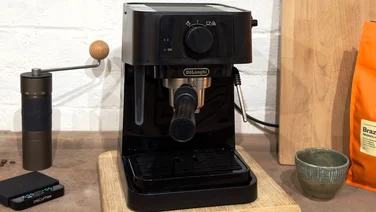To help us provide you with free impartial advice, we may earn a commission if you buy through links on our site. Learn more

- Espresso lungo mode makes good coffee
- Easy-to-use
- Compact footprint
- Plasticky steam wand
- Dispense head adjustment is clunky
- Grinder is slightly too coarse
- Espresso mode could be better
For millions of people all around the world, coffee is more than just a hot drink. What starts as an appreciation of flavour and texture often becomes a lifelong obsession; the endless quest for the perfect cup. But while some coffee aficionados are willing to sacrifice serious time and effort in their quest, the Gaggia Anima appeals to lazier instincts. This bean-to-cup coffee machine does all the hard work, promising barista-quality espresso at the touch of a button.
Gaggia Anima: Price and competition
At just shy of £550, the Anima isn’t especially pricey by the standards of most bean-to cup machines. As ever, though, the allure of one-touch operation comes at a cost: if you’re willing to shell out on a decent burr grinder, then you’ll be able to get equally good (and with a little practice, noticeably better) results from a cheaper manual espresso machine such as the excellent De’Longhi Scultura (£200). It just depends whether you can be bothered to take the time to perfect your own coffee grinding and tamping techniques to get the best out of it; not to mention manually removing the filter holder and cleaning out the filter between every single shot.
Look towards pricier models, however, and there’s plenty to tempt your credit card with. Keep saving and you can start to consider dramatically pricier fully-automatic machines (with one-touch cappuccino options) such as the Melitta Caffeo Barista TS (£985 at the time of writing). Of course, eager coffee aficionados with bigger budgets may find that bean-to cup machines simply don’t offer the customisability that they’d like. In that instance, it’s worth looking towards manual espresso dual-boiler options such as the superb Sage by Heston Blumenthal The Dual Boiler (£1,050).
Gaggia Anima: Design and build
The Anima is a smart-looking coffee machine. The glossy black fascia is trimmed with strips of silvery plastic, and while it’s not as suave as pricier metal-clad machines, it’s still a handsome device. It certainly feels solid and well-made, too, with doors and flaps around the body opening and shutting with a reassuringly firm snap, and the water reservoir slots snugly into place.
The Anima is a relatively compact machine, which will appeal to those with smaller kitchens, but bear in mind that you do need plenty of clearance above it – the removable 1.8 litre water reservoir and integrated 250g bean hopper are both accessed from above. Unlike many rival machines, though, you’re not limited to using beans alone: a small hatch on the Anima’s top allows you to use the provided scoop to brew a single serving of ground coffee if you get desperate.
There are only two moans on the build quality front: the steam wand both looks and feels plasticky and cheap, and the adjustable dispense head also fails to inspire confidence. The head does move up and down to accommodate different sized cups and mugs, but our gripe is that it doesn’t do so smoothly – the head judders up and down due to the plastic sliding mechanism.
Gaggia Anima: Ease of use and cleaning
Using the Gaggia couldn’t be simpler, though. The clear, uncluttered LCD display is accompanied by six clearly labelled buttons, and if you delve into the menus you can choose between five strengths of coffee, three temperature settings, and customise the amount of water used for the two coffee modes. Once you’ve dialled in your preferred settings, or just left it on its default settings (more on which later), you can choose between the Espresso, Espresso Lungo (a ‘long’ espresso with more water), hot water, and steam functions with a single press of a button.
Cleaning is relatively simple, too. The Anima goes through a self-cleaning process when you power it on and off to keep the coffee dispenser clean, and you can just whip off the steam head to clean it manually after you’ve used it. As ever, you’ll need to buy dedicated cleaning tablets to keep the machine free from limescale, as well as degreasing tablets for removing coffee residue once a month, but handily the brew group (where all the coffee-making magic happens) can be removed via a door at the side to give it its recommended weekly rinse in lukewarm water.
If you’re in an area with particularly hard water, then we’d recommend shelling out for the optional Intenza+ water filter. This inserts directly into the Anima’s water tank and cuts down the chances of the machine getting clogged quite so quickly with limescale.
Gaggia Anima: Coffee quality
Straight out of the box, the Anima arrived set to the highest coffee strength and at its maximum brew temperature. This is a good thing: we experimented with lowering the settings, and with our selection of beans from Square Mile Coffee Roasters, the results were disappointingly watery and thin.
Check out Square Mile Coffee Roasters’ coffee selection here
As Gaggia is an Italian brand, we suspect the Anima has been designed to work best with Italian of French roast beans which are typically roasted very dark – a choice which means that the beans’ flavour extracts very quickly into water. With our fresh and lightly roasted beans (as is the current trend), the Anima needed to remain at its maximum settings in order to produce good results, and we had to dial the grind control right up to get a grind fine enough for espresso. In fact, we’d have preferred an even finer grind; even at these settings the Gaggia is slightly coarser than is ideal.
However, the Anima is capable of making consistent, good-quality coffee. The Espresso Lungo mode was our favourite, producing a tasty, balanced cup of coffee, whereas the plain espresso mode yielded a smaller 40ml shot with a slightly syrupy texture. Notably, the espresso tended towards under-extraction, missing some of the rich, deep flavours that are extracted at the very end of the shot. It is possible to tailor both modes to produce anywhere between 10ml and 230ml of coffee, however, so there is leeway for getting a balance between the two, depending on your own personal tastes.
If you’re more a cappuccino kind of person, then the steam wand may prove a tad annoying: it’s rather short and doesn’t have a huge range of movement. This means that you need to pull the machine right out on the countertop to get a good view of what’s going on inside your steaming jug – which isn’t always ideal if you have the machine positioned further back on a kitchen counter.
As we’d expect for a single boiler design (the Anima has one boiler to supply both hot water for steaming and making coffee), the Anima does take a little while to build up a head of steam. We also found that the steam supply would occasionally running out halfway through steaming larger amounts of milk, forcing us to press the steam button a second time.
Gaggia Anima: Verdict
The Gaggia Anima isn’t quite the perfect all-rounder we might have hoped for. That said, if you’re hankering for good quality coffee with a minimum of faff, then this is a bean-to-cup machine which delivers consistently fine-tasting espresso without costing the earth – and there’s just enough options to get good (if not the best) results from most coffee beans. Just don’t be surprised if you find yourself lusting after an even pricier machine a year down the line – the Anima’s minor shortcomings may set even the most level-headed coffee drinker on the road to obsession.







